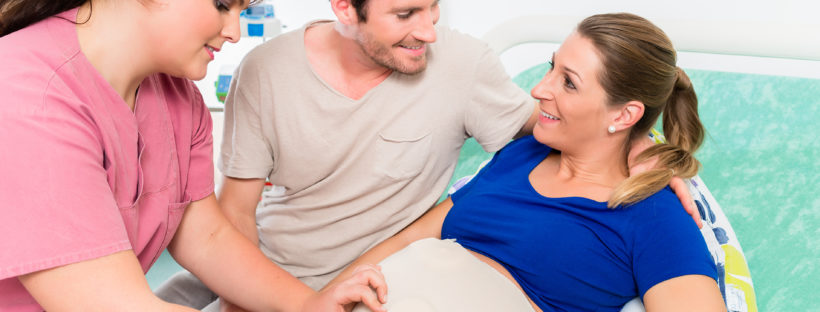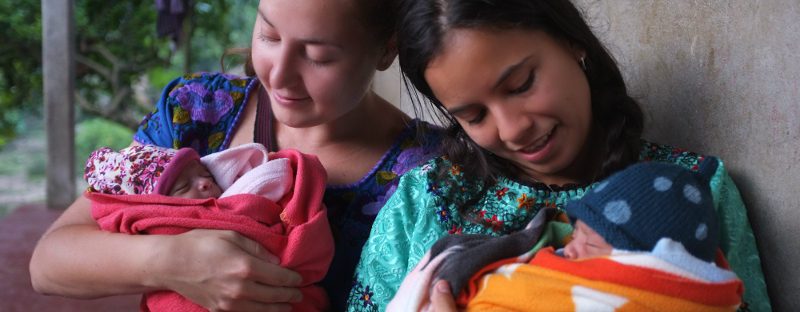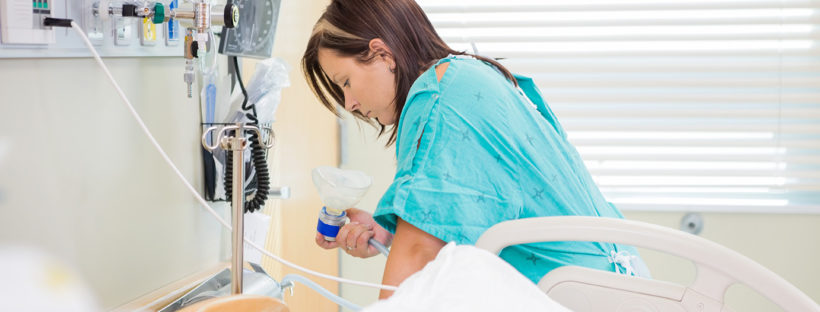By Amy Smith, Student Nurse at MGH Institute of Health Professions, Boston
I could feel the excitement in the room as I entered. The couple was receptive to my questions and suggestions; and the woman was more than happy to involve me in her care. I tried to build rapport even though I was nervous in my role as a nursing student. This was the first time I had assisted a woman in labor and, after her membranes were artificially ruptured, her contractions started to come about two minutes apart. At one point, I had my hand on her back and her husband smiled at me across the room and signaled for to me to remove my hand! It was a great moment in which the support person and I connected! I remained quiet during her contractions and I asked her if she wanted me to breathe with her but she said she had it under control. I kept thinking back to my own labors and what I felt I wanted from support people so I asked her if she would like lower back counter pressure but she refused. The family had not done a childbirth preparation course so I assumed that their interest or skills with working through labor was limited. I thought that they would need my help more yet her prenatal yoga practice seemed to have given her the tools she needed to get through her labor. The tools I offered her personally were meditative. I told her to focus on her favorite place, to discuss her needs and frustrations with us in between contractions and reassured her that I was there for her to breathe with her and regulate her breathing as needed.
Reflecting on the Nursing Care Women and Babies Deserve virtues I used during this experience, I believe they were humility and engagement. Humility in that I had to understand I did not know what was best for this family. I assumed they would want and need what I needed during childbirth or skills I learned from the comfort measures video I used to prepare for this clinical experience. The woman decided what she needed and I was there to support her. In respecting their wishes I could engage with the family. Before I left them for the day they commented, “We felt like we had our own doula”. It was easy and a pleasure to engage with this couple and follow their commands and offer suggestions. I told them I had never wanted to stay at clinical so much as I did with them. I will always remember this family.
Additional Resources
AWHONN’s Nursing Care and Women Babies Deserve Poster – AWHONN’s statement on ethical nursing practice, Nursing Care Women and Babies Deserve, is rooted in the American Nurses Association’s Code of Ethics for Nurses, and provides nurses with core elements of ethical nursing practice for our specialty and corresponding examples of the virtues of ethical practice in action.
Read a commentary about Nursing Care Women and Babies Deserve in AWHONN’s journal Nursing for Women’s Health. Consider submitting your own story of how you or your colleagues practice nursing care that women and babies deserve at https://www.awhonn.org/?NursingCare
 Amy is an ABSN student at MGH Institute of Health Professions, Boston. She was a stay at home mother for 12 years, a community coordinator for a non profit kids running program and a volunteer at Dana Farber Cancer Institute in Boston before deciding to enter the nursing field. With extensive volunteer experience from a camp for blind & visually impaired adults and children, to co-president of an elementary school PTO, she enjoys working with diverse groups of all ages. Amy aims to work in labor and delivery after graduation in August 2017 but is also interested in global health and epidemiology. She has intentions to keep making a difference in the lives of those she may never meet again.
Amy is an ABSN student at MGH Institute of Health Professions, Boston. She was a stay at home mother for 12 years, a community coordinator for a non profit kids running program and a volunteer at Dana Farber Cancer Institute in Boston before deciding to enter the nursing field. With extensive volunteer experience from a camp for blind & visually impaired adults and children, to co-president of an elementary school PTO, she enjoys working with diverse groups of all ages. Amy aims to work in labor and delivery after graduation in August 2017 but is also interested in global health and epidemiology. She has intentions to keep making a difference in the lives of those she may never meet again.



 Evgeniya Larionova received her Bachelors of Science in Nursing from MGH Institute of Health Professions. She is a founder and an Artistic Director of AMGITS Drama&Poetry Club at the Boston Living Center. She is a member of the student Leadership Committee of the Harvard Medical School Center for Primary Care. Evgeniya is passionate about infectious diseases, community health and integrating holistic care in modern practices. In her spare time she plays in the Russian theater, enjoy reading, playing the guitar and hiking.
Evgeniya Larionova received her Bachelors of Science in Nursing from MGH Institute of Health Professions. She is a founder and an Artistic Director of AMGITS Drama&Poetry Club at the Boston Living Center. She is a member of the student Leadership Committee of the Harvard Medical School Center for Primary Care. Evgeniya is passionate about infectious diseases, community health and integrating holistic care in modern practices. In her spare time she plays in the Russian theater, enjoy reading, playing the guitar and hiking.
 November is National Adoption Month.
November is National Adoption Month.


 Michelle Collins is currently Professor of Nursing and Director of the Nurse-Midwifery education program at Vanderbilt University School of Nursing. In addition to the teaching and administrative aspects of her job, she maintains an active clinical practice as part of the Vanderbilt School of Nursing faculty nurse-midwifery practice. Currently she is a blogger for Nashville Public Television for the popular series Call the Midwife.
Michelle Collins is currently Professor of Nursing and Director of the Nurse-Midwifery education program at Vanderbilt University School of Nursing. In addition to the teaching and administrative aspects of her job, she maintains an active clinical practice as part of the Vanderbilt School of Nursing faculty nurse-midwifery practice. Currently she is a blogger for Nashville Public Television for the popular series Call the Midwife.




 Lynn Erdman is the CEO of AWHONN with more than 30 years of experience in the healthcare and nonprofit sectors. She is a highly skilled national leader in the field of nursing and previously held key national leadership positions with three global health organizations: the American Cancer Society, the American College of Surgeons, and the Susan G. Komen Global Headquarters.
Lynn Erdman is the CEO of AWHONN with more than 30 years of experience in the healthcare and nonprofit sectors. She is a highly skilled national leader in the field of nursing and previously held key national leadership positions with three global health organizations: the American Cancer Society, the American College of Surgeons, and the Susan G. Komen Global Headquarters.